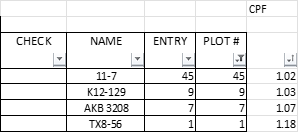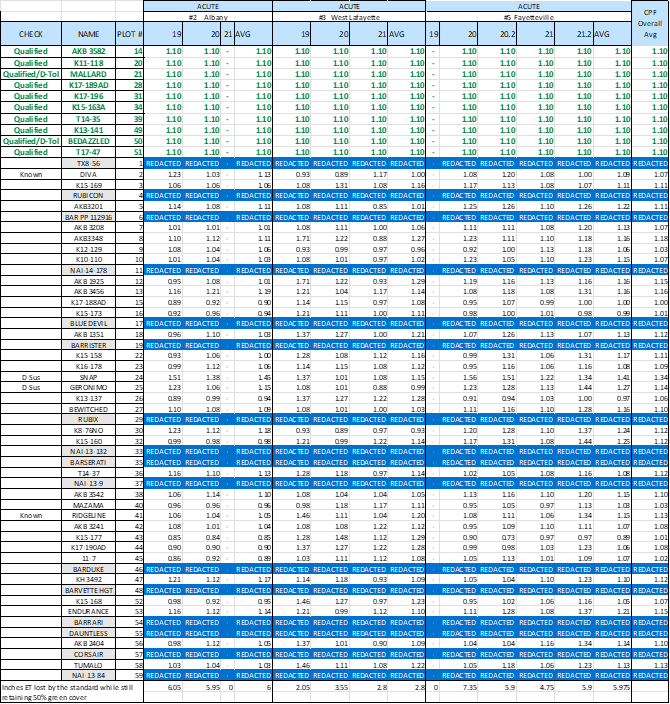|
Cultivar Plant Factor (CPF) proves an effective tool in defining and quantifying the term “drought tolerance” with relation to turfgrass evaluation. CPF methodology encourages performance-based selection relative to a known standard over broad geographic range. CPF also moderates the impacts of over and under performance years. Correctly applied CPF methodology offers a powerful tool to water providers seeking to drive sustainable outdoor water conservation solutions. What is CPF Cultivar Plant Factors, or CPF is a method of relating performance, in this case inches of evapotranspiration (ET) lost before green cover reduces to 50%, to that of a known standard(s). Using the average of two drought tolerant standards allows for a greater variability in performance of qualified materials while also setting a very high bar. In trial 18WCPPnn the drought tolerant standards selected are TWCA Qualified cultivars Mallard (E#A97-1439) and Bedazzled (E# A97-1400) both cultivars with well documented drought tolerance. What Does CPF Mean The CPF is what percent of the standard(s) water use does a given cultivar consume. A drought tolerant cultivar will perform within 10% of a known standard. A cultivar that performs within the standard rage for TWCA Qualification in Albany OR 2019 could safely be expected to maintain 50% green cover through 5.445 in. water loss whereas the susceptible cultivar suffered a water loss of 1.5 times the drought tolerant standard or over nine inches of water required to maintain 50% green cover. How Does CPF Work In the most recent application of Cultivar Plant Factors (CPF), the methodology was especially useful in several cases where, in prior methodologies, evaluation became largely subjective near the edges of the confidence intervals and, relative to different locations. An example is entry number forty-five (45) E#11-7. E#11-7 performed above the range for qualification across all considered locations. The performance was also within the confidence interval for qualification in at least one year and one location. The performance criteria delineated in the Qualification Report outlines the specific standards the RRC uses and ensure transparency and clarity in the process. E#11-7 was ultimately rejected from the qualification process by virtue of its inconsistent performance through time across multiple locations. E#11-7 had exceptional performance in the Albany OR location (site #2) outperforming the CPF by twenty four percent. Roughly translated it provides an additional 1.5 inches of water loss potential before reaching 50% green cover. West Lafayette (site #3) recorded an excellent first year within range of Qualification in 2019. However, a consistent annual performance outside the range of drought tolerance over subsequent data collections disqualifies the cultivar despite an overall score falling within range. Similarly, an increased number of dry downs over two years of data collection contributed a muting effect to the overall CPF scores. Noting the consistent performance trends for the first drydown of each data year and a similar pattern with the 2nd drydown of each data year the RRC coopted to consider the first drydown of a set and the 2nd drydown as a matched data set. Doing so re-calculates the overall CPF average value(s) for each cultivar. This lens brings into focus two different performance stories; one of Qualification and one of falling just shy the mark. Ultimately it is the inconsistency in performance that proves the undoing of many cultivars as it does in the case, E#11-7. Figure 4 What Does CPF Mean The CPF is a measure of water demand to reach 50% green cover. It is an expression of the percentage of water lost by a drought tolerant standard. in the case of E#11-7 the overall CPF of 1.02 means the water use when averaged is within two percent of the drought tolerant standard(s). Why Use CPF The greatest advantage to utilizing the CPF methodology is the ability to create meaningful comparison of drought performance across locations based on objective data evaluated uniformly. This enhances the ability of researchers to quickly make informed decisions about regional adaptability and ensure that only cultivars with demonstrated drought tolerance across the geographic range receive TWCA Qualification. TWCA Qualification report 2022
0 Comments
Leave a Reply. |
Program AdministratorJack Karlin is the Program Administrator for TWCA. His interest is in using policy and the built environment to create livable and sustainable communities. Archives
February 2024
Categories
All
|
|
|
Turfgrass Water Conservation Alliance
|
Copyright © 2022 Turfgrass Water Conservation Alliance. All rights reserved.







